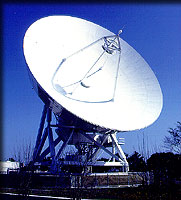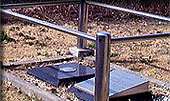| |
|
 |
LAT: 36°06ĀĆ11ĀćN LON: 140°05ĀĆ19ĀćE ALT: 44.6 m |
|
Operation of Tsukuba VLBI Station ended
in December, 2016.
|
|
| |
 |
| address |
 |
1 Kitasato, Tsukuba-shi, IBARAKI |
| antenna type |
Cassegrain antenna, AZ-EL mount |
| antenna diameter |
32 m |
| antenna weight |
550 t |
| receiver frequency |
S-band 2.12-2.52GHz
X-band 7.78-8.98GHz
K-band 19.5-25.0GHz |
| in-service date |
March, 1998 |
|
|
| |
|
|
The Tsukuba VLBI Station is the core station of the GSI VLBI observation network. Its antenna has a large aperture (32-m diameter) and an unprecedented high mobility of 3Āč/sec.
With its exceptional capability, the station plays a leading role in geodetic VLBI in Japan, ranked with the Shanghai Astronomical Observatory as the leading station in Asia.
Performing more than 100 domestic / international observations per year,
it serves to maintain the national geodetic reference system, to monitor
the variation in Earth rotation and the displacement of plates, collaborating
with universities and research organizations in Japan and overseas. ĀB
There is a metal markerĀiVLBI markerĀjon the ground adjacent to the antenna.
With its precisely determined position by repeated VLBI observations, this
marker supplies a definition for the datum azimuth in the national geodetic
reference network, which means that the azimuth angle between the marker
and the origin of longitude and latitude (Azabudai, Minato-ku, Tokyo) has
been determined to serve as a starting or reference azimuth.
|
 |
antenna moves horizontally on rails with 4 great wheel of its bottom
|
 |
observation room in station building ( radio signals from celestial
objects are recorded here after the antenna receives them )
|
 |
a VLBI marker ( metal marker ) on the ground adjacent to the antenna
|
|
|
|
  |
|